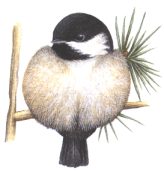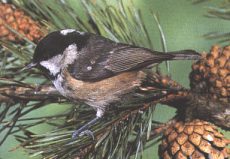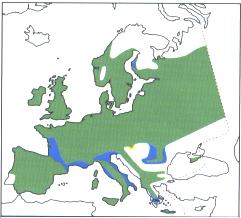Parus Ater - Coal Tit
Source: British Garden Birds (www.garden-birds.co.uk)
| Length | 11,5 cm |
| Weight: | 8-10 g |
| Present: | All Year |
| Wing Span: | 17-21 cm |
| Breeding Pairs in Great Brittan: | 610 000 |
| Status: | Green List |
 Description
Description
The Coal Tit is a small tit, in fact the smallest European tit, and could be confused
with the almost indistinguishable Marsh Tit and Willow Tit if it was not for the white patch on the
nape. While it behaves like a Blue Tit, there is no
blue in its plumage.
The upperparts are a olive-grey, the underparts buff coloured. The crown and large bib are
black, while the cheeks and nape are white. There are also two white wing bars on each
wing.
Juveniles are browner above, and the underparts, cheeks, nape, and wing bars are more
yellow.
Feeding
Insects and conifer seeds are the Coal Tit's diet. In the garden, they choose black sunflower seeds, sunflower hearts, and occasionally suet. They store food, particularly when food is plentiful, for consumption later, albeit usually within a few days.
Voice
The high pitch song of the Coal Tit, a repetitive "pee-chew", is similar to
that of the Great Tits but faster. 
Breeding
Breeding Coal Tits will nest in hollows in trees or in mouse holes. The nest is similar
to that of the Blue Tit (i.e. made from moss, wool, dead leaves and spiders' webs) except
that it is moss-lined.
The Coal Tit's small (15 mm by 12 mm) eggs are smooth and glossy, and white with
reddish-brown speckles. The female incubates the eggs by herself. After the young hatch,
they are fed by both parents.
| Breeding Starts | Number of Clutches | Number of Eggs | Incubation (days) | Fledge (days) |
| mid-April | 1-2 | 7-12 | 14-16 | 16-19 |
Distribution

[ Home ] [ Bird overview ]